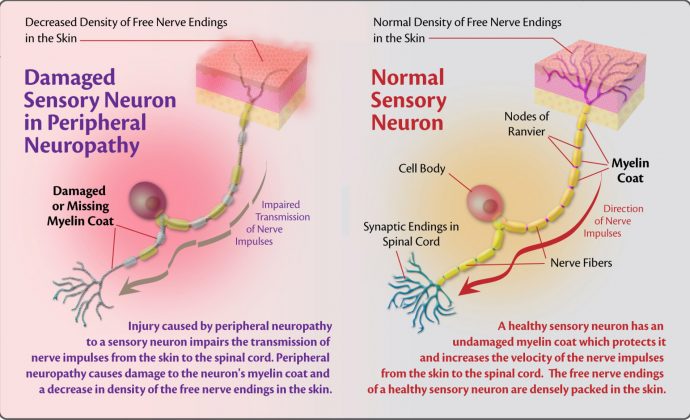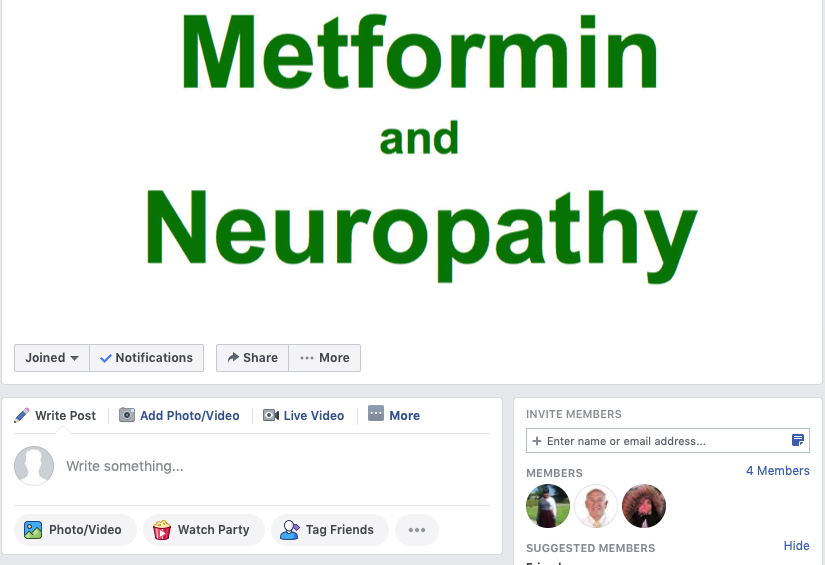There are over 150 causes of peripheral neuropathy. Some causes are exceedingly rare while other causes are very common. The majority of cases of peripheral neuropathy in the US and Canada are caused by diabetes, prediabetes, excessive alcohol consumption, and advanced age. It is estimated that these conditions account for well over 80% of the cases of peripheral neuropathy in the USA and Canada.
The following, partially taken from the website of The National Institutes of Health, is a more complete list of the causes of peripheral neuropathy:
- Nutritional or vitamin imbalances, alcoholism, and exposure to toxins can damage nerves and cause neuropathy. New research indicates that vitamin B1 deficiency, more commonly known as LowB1, frequently affects people who are diabetic, the elderly, people who drink alcohol excessively, people who are significantly over weight, people on certain medications, and many physicians believe prediabetics, as well. In fact, vitamin B1 deficiency is likely the most common nutritionally based cause of peripheral neuropathy. Vitamin B12 deficiency, vitamin E deficiency, and excessive intake of vitamin B6 are less common nutritionally based causes of peripheral neuropathy. Several medications have been shown to occasionally cause neuropathy.
- Physical injury (trauma) is the most common cause of acquired single-nerve injury. Injury from automobile accidents, falls, sports, and medical procedures can stretch, crush, or compress nerves, or detach them from the spinal cord. Less severe traumas also can cause serious nerve damage. Broken or dislocated bones can exert damaging pressure on neighboring nerves and slipped disks between vertebrae can compress nerve fibers where they emerge from the spinal cord. Arthritis, prolonged pressure on a nerve (such as by a cast) or repetitive, forceful activities can cause ligaments or tendons to swell, which narrows slender nerve pathways. Ulnar neuropathy and carpal tunnel syndrome are common types of neuropathy from trapped or compressed nerves at the elbow or wrist. In some cases, there are underlying medical causes (such as diabetes) that prevent the nerves from tolerating the stresses of everyday living.
- Diabetes is the leading cause of polyneuropathy in the United States. About 60 – 70 percent of people with diabetes have mild to severe forms of damage to sensory, motor, and autonomic nerves that cause such symptoms as numb, tingling, or burning feet, one-sided bands or pain, and numbness and weakness on the trunk or pelvis.
- Vascular and blood problems that decrease oxygen supply to the peripheral nerves can lead to nerve tissue damage. Diabetes, smoking, and narrowing of the arteries from high blood pressure or atherosclerosis (fatty deposits on the inside of blood vessel walls) can lead to neuropathy. Blood vessel wall thickening and scarring from vasculitis can impede blood flow and cause patchy nerve damage in which isolated nerves in different areas are damaged—called mononeuropathy multiplex or multifocal mononeuropathy.
- Systemic (body-wide) autoimmune diseases, in which the immune system mistakenly attacks a number of the body’s own tissues, can directly target nerves or cause problems when surrounding tissues compress or entrap nerves. Sjögren’s syndrome, lupus, and rheumatoid arthritis are some systemic autoimmune diseases that cause neuropathic pain.
- Autoimmune diseases that attack nerves only are often triggered by recent infections. They can develop quickly or slowly, while others become chronic and fluctuate in severity. Damage to the motor fibers that go to the muscle includes visible weakness and muscle shrinking seen in Guillain-Barré syndrome and chronic inflammatory demyelinating polyneuropathy. Multifocal motor neuropathy is a form of inflammatory neuropathy that affects motor nerves exclusively. In other autoimmune neuropathies the small fibers are attacked, leaving people with unexplained chronic pain and autonomic symptoms.
- Hormonal imbalances can disturb normal metabolic processes, leading to swollen tissues that can press on peripheral nerves.
- Kidney and liver disorderscan lead to abnormally high amounts of toxic substances in the blood that can damage nerve tissue. Most individuals on dialysis because of kidney failure develop varying levels of polyneuropathy.
- Certain cancers and benign tumors cause neuropathy in various ways. Tumors sometimes infiltrate or press on nerve fibers. Paraneoplastic syndromes, a group of rare degenerative disorders that are triggered by a person’s immune system response to a cancer, can indirectly cause widespread nerve damage.
- Chemotherapy drugs used to treat cancer cause polyneuropathy in an estimated 30 to 40 percent of users. Only certain chemotherapy drugs cause neuropathy and not all people get it. Chemotherapy-induced peripheral neuropathy may continue long after stopping chemotherapy. Radiation therapy also can cause nerve damage, sometimes starting months or years later.
- Infections can attack nerve tissues and cause neuropathy. Viruses such as varicella-zoster virus (which causes chicken pox and shingles), West Nile virus, cytomegalovirus, and herpes simplex target sensory fibers, causing attacks of sharp, lightning-like pain. Lyme disease, carried by tick bites, can cause a range of neuropathic symptoms, often within a few weeks of being infected. The human immunodeficiency virus (HIV), which causes AIDS, can extensively damage the central and peripheral nervous systems. An estimated 30 percent of people who are HIV-positive develop peripheral neuropathy; 20 percent develop distal (away from the center of the body) neuropathic pain.
Genetically-caused polyneuropathies are rare. Genetic mutations can either be inherited or arise de novo, meaning they are completely new mutations to an individual and are not present in either parent. Some genetic mutations lead to mild neuropathies with symptoms that begin in early adulthood and result in little, if any, significant impairment. More severe hereditary neuropathies often appear in infancy or childhood. Charcot-Marie-Tooth disease, also known as hereditary motor and sensory neuropathy, is one of the most common inherited neurological disorders.


